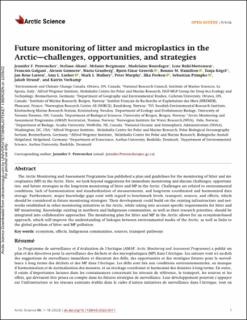| dc.contributor.author | Provencher, Jennifer F. | |
| dc.contributor.author | Aliani, Stefano | |
| dc.contributor.author | Bergmann, Melanie | |
| dc.contributor.author | Bourdages, Madelaine | |
| dc.contributor.author | Buhl-Mortensen, Lene | |
| dc.contributor.author | Galgani, Francois | |
| dc.contributor.author | Gomiero, Alessio | |
| dc.contributor.author | Granberg, Maria | |
| dc.contributor.author | Grøsvik, Bjørn Einar | |
| dc.contributor.author | Hamilton, Bonnie M. | |
| dc.contributor.author | Kögel, Tanja | |
| dc.contributor.author | Larsen, Jan René | |
| dc.contributor.author | Lusher, Amy | |
| dc.contributor.author | Mallory, Mark L | |
| dc.contributor.author | Murphy, Peter | |
| dc.contributor.author | Peeken, Ilka | |
| dc.contributor.author | Primpke, Sebastian | |
| dc.contributor.author | Strand, Jakob | |
| dc.contributor.author | Vorkamp, Katrin | |
| dc.date.accessioned | 2022-12-22T08:17:58Z | |
| dc.date.available | 2022-12-22T08:17:58Z | |
| dc.date.created | 2022-08-26T10:34:52Z | |
| dc.date.issued | 2022 | |
| dc.identifier.issn | 2368-7460 | |
| dc.identifier.uri | https://hdl.handle.net/11250/3039159 | |
| dc.description.abstract | The Arctic Monitoring and Assessment Programme has published a plan and guidelines for the monitoring of litter and microplastics (MP) in the Arctic. Here, we look beyond suggestions for immediate monitoring and discuss challenges, opportunities, and future strategies in the long-term monitoring of litter and MP in the Arctic. Challenges are related to environmental conditions, lack of harmonization and standardization of measurements, and long-term coordinated and harmonized data storage. Furthermore, major knowledge gaps exist with regard to benchmark levels, transport, sources, and effects, which should be considered in future monitoring strategies. Their development could build on the existing infrastructure and networks established in other monitoring initiatives in the Arctic, while taking into account specific requirements for litter and MP monitoring. Knowledge existing in northern and Indigenous communities, as well as their research priorities, should be integrated into collaborative approaches. The monitoring plan for litter and MP in the Arctic allows for an ecosystem-based approach, which will improve the understanding of linkages between environmental media of the Arctic, as well as links to the global problem of litter and MP pollution. | en_US |
| dc.language.iso | eng | en_US |
| dc.publisher | NRC Research Press | en_US |
| dc.rights | Navngivelse 4.0 Internasjonal | * |
| dc.rights.uri | http://creativecommons.org/licenses/by/4.0/deed.no | * |
| dc.subject | Microplast | en_US |
| dc.subject | Microplastic | en_US |
| dc.title | Future monitoring of litter and microplastics in the Arctic—challenges, opportunities, and strategies | en_US |
| dc.type | Journal article | en_US |
| dc.type | Peer reviewed | en_US |
| dc.description.version | publishedVersion | en_US |
| dc.rights.holder | Copyright 2022 Authors Aliani, Bergmann, Bourdages, BuhlMortensen, Galgani, Gomiero, Granberg, Grøsvik, Hamilton, Kögel, Larsen, Lusher, Mallory, Murphy, Peeken, Primpke, Strand, and Vorkamp, and The Crown | en_US |
| cristin.ispublished | true | |
| cristin.fulltext | original | |
| cristin.qualitycode | 1 | |
| dc.identifier.doi | 10.1139/AS-2022-0011 | |
| dc.identifier.cristin | 2046244 | |
| dc.source.journal | Arctic Science | en_US |
| dc.relation.project | Havforskningsinstituttet: 15517 | en_US |
| dc.relation.project | Havforskningsinstituttet: 15293 | en_US |
| dc.relation.project | Havforskningsinstituttet: 15761 | en_US |
| dc.subject.nsi | VDP::Bebyggelses- og reguleringsplanlegging: 234 | en_US |
| dc.subject.nsi | VDP::Building and regulation planning: 234 | en_US |
| dc.subject.nsi | VDP::Bebyggelses- og reguleringsplanlegging: 234 | en_US |
| dc.subject.nsi | VDP::Building and regulation planning: 234 | en_US |
| dc.subject.nsi | VDP::Bebyggelses- og reguleringsplanlegging: 234 | en_US |
| dc.subject.nsi | VDP::Building and regulation planning: 234 | en_US |
| dc.identifier.citation | Arctic Science, 2022. | en_US |

